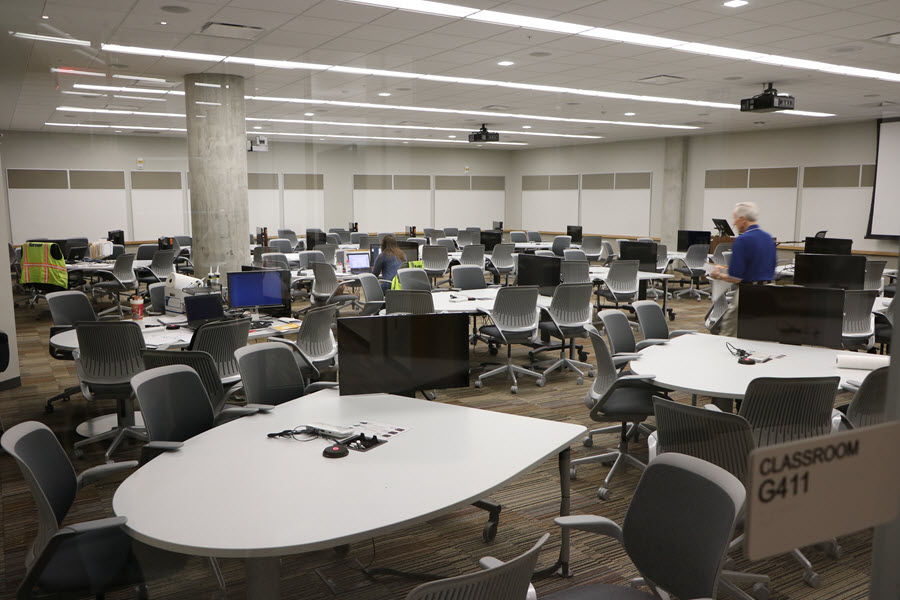By Doug Ward
Earlier this week, I interrupted two students in a small room at Spahr Engineering Library at KU.

The students, Tom Ellison and Nathan Marlow, were working on problems for a dynamics class. Each had tablet computers and used styluses to work problems by hand in OneNote. Ellison’s computer was connected wirelessly to a large monitor on a wall, via an adaptor he checked out from the library, and the two of them conversed and shared ideas as they worked.
It was an impressive scene of collaboration in a space that makes collaboration easy. The room has a table for up to six people and easy access to outlets. A wall-mounted monitor is large enough for everyone at the tables to see, yet it doesn’t get in the way if students don’t need it.
Informal spaces like these are important to student life and student learning. KU Libraries, like libraries around the country, has created more of these spaces, some with tables and chairs, some with whiteboards, others with cushioned chairs and a view of campus. They are constantly in use. The new engineering building has ample numbers of these types of spaces, everything from the small rooms in the Spahr Library to booths in a food court to soft chairs in a bright atrium. Small alcoves with chairs and tables are sprinkled through the building, and students made ample use of all the spaces when I visited the building earlier this week.
These informal spaces make buildings more inviting, but they also reflect a shift toward mobile technology, a shift that is moving ever more rapidly. Within two years, smartphones will provide all the computing power you need at home or at work, Wired reports. It cites predictions from the chipmaker ARM, which recently released a new generation of processors, and a consumer trends researcher. That doesn’t mean the world will change in two years. Adoption of any new technology takes time. It does suggest a tipping point that most universities are ill-equipped to handle.
The size of computer hardware has been shrinking for decades, and if this latest prediction plays out, it will have substantial ramifications for all levels of education. Teenagers have adopted the online world as an important social sphere, with mobile phones an important connection point. Many primary and secondary schools have shifted to a bring-your-own-device model, one that incorporates students’ phones, tablets and laptops into their learning inside and outside the classroom. Pew reports that 15 percent of 18- to 29-year-olds rely predominately on their phones for Internet access, and that non-White Americans are more likely to have web access only on their phones.
A change by U.S. wireless phone carriers over the summer could add to the pressure to make mobile computing more accessible to students. The carriers began shifting the upfront costs of mobile phones to consumers, rather than building in a sort of installment plan that required two-year contracts. Those higher upfront costs could lead even more people to look at their phones as a primary device for computing and connecting to the Internet, especially if the phones have the power of laptops.
Higher education has generally been slow to adapt to these changes, and indeed there are many challenges in security, compatibility, and capacity of wi-fi networks. It has been even slower in adapting to a mobile web. Everything from university websites to scheduling systems to learning management systems lack basic functionality and usability on mobile.
That has to change, and soon, although the financial challenges are steep. IT departments constantly balance innovation with accessibility, but more than anything else, struggle with the financial demands to stay on top of quickly changing technology. Schools and departments face the same challenges, not only with providing technological access but with modernizing classrooms and other learning spaces to accommodate new technology, collaborative learning, and the flexibility that learning environments so desperately need. Those challenges aren’t likely to change anytime soon, given the hostile attitudes toward higher education in many state legislatures. Institutions simply must address those challenges, though, if they hope to remain relevant in which technology and physical environments can aid or hinder student engagement and learning.
A recent comment by Jay Bhatt, president and CEO of Blackboard, cuts to the heart of the mobile challenge in higher education. Blackboard is hardly a leader in adapting to mobile, though it has made progress of late. Bhatt’s comments are worth taking to heart:
“There is a critical disconnect between what today’s learners want, and how the educational system is serving them. The industry hasn’t changed in years. Today’s learners have a drastically different set of wants, needs and consumer preferences. Learners of all ages and at all points in their learning lifecycle today require something different. They want and expect technology to play a major role in their education. And they want education technology that is as convenient as what they’ve become accustomed to from companies like Apple and Amazon. They want mobile. They want to be able to connect with their peers. They want fast, simple, and intuitive.”
Test-optional application process plays well in university rankings
Colleges and universities that make the SAT or ACT optional may have less-than-altruistic goals in mind.
Stephen Burd of The Hechinger Report says that a test-optional application process is often portrayed as a way of diversifying the student body. The argument sounds good, he says, as standardized test scores often create barriers for minority and non-affluent students.
It usually doesn’t work that way, though.
By making standardized tests optional, Burd says, colleges and universities often draw more applicants, thus increasing the percentage of rejected applications and making themselves seem more exclusive. Students who do submit their scores on the SAT and ACT under such a system generally do so because their scores are higher than average, raising the institution’s overall average and again making the school seem more exclusive.
Those exclusivity figures play especially well in the U.S. News & World Report rankings, providing a boost to test-optional institutions and essentially punishing those that either require the ACT or SAT, or don’t.
As for the diversity argument, Burd says there is little evidence that a test-optional approach leads to a more diverse student body. Rather, it simply allows institutions to pander to the types of rankings that affluent families embrace in making college choices. Others say the test-optional approach simply needs more time to work. It’s definitely worth watching.
Briefly …
A short lecture helps students put readings into better context, Illysa Izenberg argues in an article for Faculty Focus. By short, she means 8 to 10 minutes, with the rest of class time devoted to activities, discussion and reflection. … University Business says competency-based education is “poised for explosive growth,” and it provides advice for creating such programs from institutions that have already moved in that direction. … Writing in Harvard Business Review, Jeffrey Arnett says companies should tap into millennials’ desire to find engaging work that allows them to make positive contributions to society. I’d argue that college instructors should do the same.
Doug Ward is the associate director of the Center for Teaching Excellence and an associate professor of journalism. You can follow him on Twitter @kuediting.

















Recent Comments